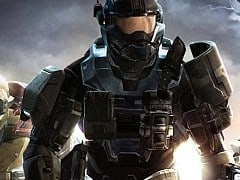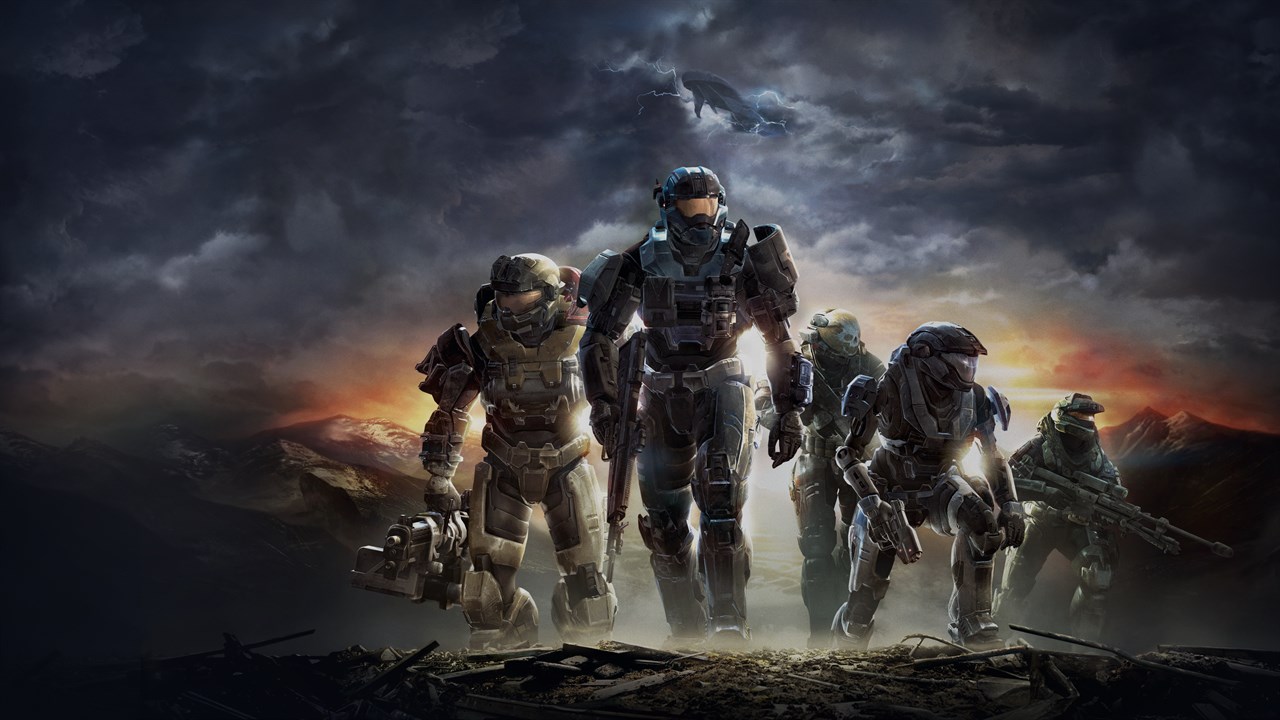You can trust VideoGamer. Our team of gaming experts spend hours testing and reviewing the latest games, to ensure you're reading the most comprehensive guide possible. Rest assured, all imagery and advice is unique and original. Check out how we test and review games here
If there is any lingering doubt about the sheer magnitude of Halo, it is eradicated in an instant. Here we are, in a plush West End hotel, with Channel 5’s The Gadget Show presenter Jason Bradbury as host, to get a hands on preview of a multiplayer beta. A multiplayer beta. If this were any other game you’d think, “whatever”. But then this is not any other game. This is Halo.
More specifically, Halo: Reach, the next Halo game from Bungie. And we’re hugely excited, not just because we know full well that multiplayer is what’s best about Halo, but because Halo’s multiplayer is one of the best things about gaming. Despite Modern Warfare’s huge popularity, Halo 3’s multiplayer, both competitive and cooperative, continues its impressive run near the top of the most played Xbox LIVE games charts. Put simply, Halo’s multiplayer is fantastic, and as our trembling hands navigate Reach’s menu screen for the first time, we dribble at the prospect that in only a few seconds we’ll be playing what will undoubtedly be the best Halo multiplayer experience ever created.
Why? Iteration. With each iteration, Halo’s multiplayer gets better. Halo’s multiplayer was great; Halo 2’s multiplayer was brilliant (and important); Halo 3’s multiplayer was masterful, and Halo 3: ODST’s multiplayer was, well, pretty much the same, but it had Firefight, making it ever so slightly better. It follows, then, that Halo: Reach’s multiplayer will be jaw-droppingly, ball-bustingly awesome.
And so it proves, in a reassuring fashion. Our play test only sees three game modes across three maps, but what fun! We begin with eight-player Oddball on Powerhouse, a new map that supports all available party types. We take the opportunity to familiarise ourselves with the new controls and new mechanics. The big two: grenades and shooty shooty bang bang, are still on the left and right triggers respectively, of course. But the new persistent, re-usable armour abilities are default mapped to LB, and the classic Halo melee, or the new third-person assassinations if you’re in the right place, are now default mapped to RB.
At the beginning of a match, and indeed when you die during one, you can select your load out. Load outs only represent the armour ability and weapon set the player chooses to start with in a multiplayer match, so while we at first think of Modern Warfare, the comparison quickly becomes irrelevant; load outs aren’t player created but pre-determined by the gametype, map, and other factors. The load out governs your armor ability, starting weapon, secondary weapon, and grenade cache. That’s it. You may wish to start with the Jet Pack (yes, there are jet packs in Halo!), or perhaps Sprint, or, if you’re feeling like turtling, Armour Lock. The choice is yours, and it’s a strategic one.
Here’s how they work: displayed on the bottom left of the screen is a small icon representing the equipped armour ability. Around it is a circle that evaporates as you use the ability. Take the Spartan-only ability Sprint, for example. As you hold down LB, you gain a short burst of speed. Once depleted, there is a short recharge before you can sprint again (true of all armour abilities), thus limiting its use.
The important thing to note is that all five (that we know of) armour abilities are useful. Balance is key, and initially it appears as if the Jet Pack is overpowered because everyone and their dog uses it straight away (mid-air assassinations are a beautiful thing). But soon things settle down, and we experiment with others. Sprint, for example, is hugely useful, because it allows you to race from objective to objective in the blink of an eye. Armour Lock, which allows the player to create a temporary personal invulnerable shield that deflects rockets, Gravity Hammer blows and even vehicles, is also great, particularly when you’re defending an objective. Even better, when the armour lock dissipates, it releases an EMP field that disables enemy shield and vehicles nearby. Take that suckers.
After our practice, we start playing seriously. Here, we get our first taste of one of the brand new game modes: Stockpile. It’s best described as capture the flags, with an emphasis on the plural. The match begins with neutral flags spawned around the map, and two active capture points – one for each team. The idea is to capture a flag, then drop it off in your capture point. The interesting thing is zones only register scores at specific intervals. Our games ended up being frantic to-and fro-affairs in which both teams tried desperately to steal flags from capture zones before they registered them. It’s fun – the kind of fun Halo has on tap.
Now, Covy Slayer on new map Swordbase. This traditional Covenant team based deathmatch proves instantly gratifying: Swordbase, a sci-fi human interior, is a small, multi-tiered map designed for chaos and well suited to running and gunning lone wolves. With an anti-grav lift on the lower level, we spend a lot of time bouncing up and down as if on some magical trampoline, sniping enemies with the lovely Plasma Repeater – the Covenant’s answer to the UNSC Assault Rifle. Awesome.
Swordbase also properly introduces us to Reach’s Elites, new and improved following an absence from Halo 3: ODST. The Elites, this time around, are more than just re-skinned Spartans. They play differently. Very differently. They’re tough to take down, for example, have different assassination animations, start with different weapons, and have different armour abilities. Elites can’t Sprint; instead, they can Evade, aka do that annoying barrel roll they’re fond of when under the governance of the AI. Elites regenerate health over time, whereas Spartans must use health packs to recover life. And, of course, there’s nothing cooler than an Elite using the Active Camo armour ability. Stab.
As you’d expect, there are concerns around balance. Does the Elite’s tougher skin make it better than the Spartan? Is Evade better than Sprint? At the moment it’s hard to tell, although the consensus among journalists is that Evade doesn’t feel particularly useful. Only time, and the multiplayer beta, will tell.
Then, on to the Halo: Reach multiplayer beta’s creme de la creme. Invasion, a 12-player, two team assault or defence of a base, is the most interesting of the new game modes we play. One team of Elites assaults a base defended by a team of Spartans on a map custom made for this game mode: Boneyard. Boneyard, a sprawling map packed with refineries, bulkheads, a junk yard, a loading bay, multi-tiered bases and towering cranes, is huge. Perfect, really, for what it was created for: objective-based vehicular chaos.
At first, though, it’s weapons only, and that’s because Invasion is a three-phase match that revolves around unlocking new abilities as objectives are completed. It begins with an assault on the Spartan high ground by the Elites. It’s easy to get sniped if you attack from the front, so it’s best to try to sneak in via stairs set on the sides – the Active Camo armour ability is particularly useful here. One of two clearly defined objectives needs to be captured to trigger phase two and force the Spartans to fall back to a previously locked out area and defend three new capture points. It’s at this point that vehicles are unlocked, as well as new load outs and the new armour abilities they bring. Capture one objective and the data core presents itself. The idea is to steal the core, like you would a flag, and bring it to a waiting Phantom. Here things get proper mental as the really powerful vehicles, including the Scorpion tank (in which I manage an uninterrupted 15-kill streak), unlock. If the Spartans keep the core from going walkies, they win. If they don’t, they lose. Then the teams switch, and it starts all over again.
Invasion’s great. It’s easy to understand, objectives are clearly marked, and Boneyard is wonderfully designed for the act. Respawning works like MAG’s respawning should have; you have the chance to change your load out, and pick your spawn point (including spawning right next to your buddy – the teams are divided up into pairs of players), but you never feel like you’re waiting too long. It’s easy to see Invasion proving hugely popular during the beta. Matches fly by and neither assaulting nor defending seems easier. Assaulting is more fun, of course, but then it always is, isn’t it?
Post-match, you get a Carnage Report. Here, you see the medals you gained from the match: First Strike, Assassin, Killing Spree, Expert Marksman, whatever. You also see your earned credits (cR) go up, fuelled, hopefully, by a nice Victory Bonus. Credits are the payout and currency for doing cool stuff in Reach. They’re used to buy aesthetic customisation: new helmets, shoulder pads and the like. But they’re also a metric that informs your Military Rank. Your Military Rank, of course, is tied into experience gain, which channels into your progression up the ranking ladder. As you level up, you’ll get access to more customisation elements and in some cases customisation regions, in the Armoury.
The Armoury is only a speck on the landscape that is Halo: Reach’s new stuff. Obviously, there’s too much to expunge in what’s an already gargantuan preview, but here are some more highlights: the beta will include four maps, the aforementioned Powerhouse, Swordbase, and Boneyard, as well as one we didn’t get to play, Overlook. It’ll include classic game types and four new game types: Invasion, Stockpile, Headhunter (described as a new party game objective offering where the goal is to collect and capture the most skulls), and Generator Defence, which pits three Spartans against three Elites on the Overlook map.
How can we forget the new weapons, like the Designated Marksman Rifle (the re-jigged Battle Rifle), and returning vehicles (you’ll have to wait till the release of the finished game to get your hands on new vehicles like the Falcon)? And we haven’t even breathed a word on the new social, community, and matchmaking features, player rewards, or the single-player. Phew.
Oh well. We’ll have to make do with what we’ve experienced and what that tells us about the game. In short: Halo: Reach’s multiplayer is very Halo. Yes there are jet packs, load outs, new weapons, new game modes and other lovely gubbins, but the experience it offers is familiar, at least in a multiplayer sense. The armour abilities add strategic depth, the new game modes are fresh and exciting, but the skills honed through hours of online Halo 3 play are transferable. The Rocket Launcher feels the same. The floaty jumping, the shield, the teabagging, the Plasma Pistol, the Needler, all feel the same. Halo: Reach is Halo at heart, and, ergo, it’s stupendously good fun.
As our two and a half hour hands on with Halo: Reach comes to an end, we can’t help but feel a tinge of sadness. Sadness that we didn’t nail a mid-air assassination, and sadness that we won’t get to play the game again until the release of the beta. This is undoubtedly a good sign, one that for many Halo fans signifies the return of the true king of console FPS. Time to polish that crown…
The Halo: Reach beta will be exclusively available through the Halo 3: ODST menu on May 3. Halo: Reach is due out later this year.

/https://oimg.videogamer.com/images/463d/halo_reach_48.jpg)
/https://oimg.videogamer.com/images/a93d/halo_reach_44.jpg)






